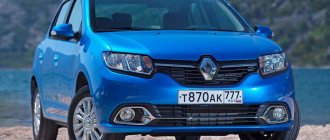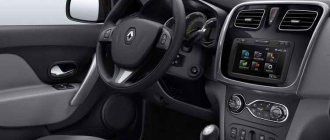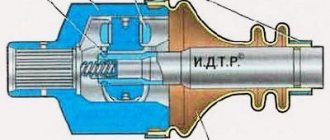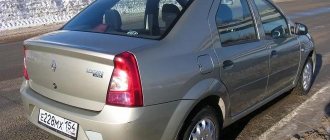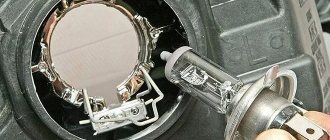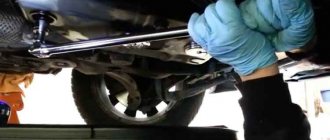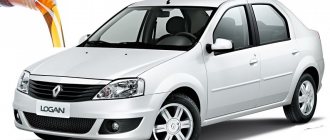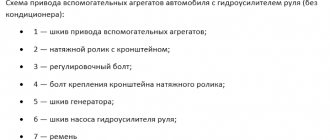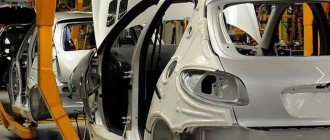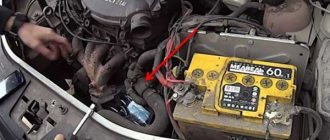Russia
Engine Renault Logan restyling 2021, sedan, 2nd generation
| Modifications | Engine volume, cm³ | Engine make |
| 1.6 l, 82 hp, gasoline, manual transmission, front-wheel drive | 1598 | K7M |
| 1.6 l, 102 hp, gasoline, automatic transmission, front-wheel drive | 1598 | K4M |
| 1.6 l, 113 hp, gasoline, manual transmission, front-wheel drive | 1598 | H4M |
Engine Renault Logan 2014, sedan, 2nd generation
| Modifications | Engine volume, cm³ | Engine make |
| 1.6 l, 82 hp, gasoline, manual transmission, front-wheel drive | 1598 | K7M |
| 1.6 l, 82 hp, gasoline, robot, front-wheel drive | 1598 | K7M |
| 1.6 l, 102 hp, gasoline, manual transmission, front-wheel drive | 1598 | K4M |
| 1.6 l, 102 hp, gasoline, automatic transmission, front-wheel drive | 1598 | K4M |
| 1.6 l, 113 hp, gasoline, manual transmission, front-wheel drive | 1598 | H4M |
Engine Renault Logan restyling 2009, sedan, 1st generation
| Modifications | Engine volume, cm³ | Engine make |
| 1.4 l, 75 hp, gasoline, manual transmission, front-wheel drive | 1390 | K7J |
| 1.6 l, 84 hp, gasoline, manual transmission, front-wheel drive | 1598 | K7M |
| 1.6 l, 103 hp, gasoline, manual transmission, front-wheel drive | 1598 | K4M |
| 1.6 l, 103 hp, gasoline, automatic transmission, front-wheel drive | 1598 | K4M |
Engine Renault Logan 2004, sedan, 1st generation
| Modifications | Engine volume, cm³ | Engine make |
| 1.4 l, 75 hp, gasoline, manual transmission, front-wheel drive | 1390 | K7J |
| 1.6 l, 90 hp, gasoline, manual transmission, front-wheel drive | 1598 | K7M |
About the history of development and design features of the units
The 1.6 and 16-valve engine differs from the newest modifications; they are the absence of a mechanism for regulating valve timing; this engine design has significantly reduced the dynamic capabilities of the car.
But the advantages remain excellent maintainability and durability, that is, increased engine life, thanks to simple design solutions from the manufacturer. The engine is powered by a 1.4-liter 8-valve engine, which confirms the identical layout and similar design aspects of both engines.
The changes affected the following components and systems:
- the cylinder volume increased (1.6 liter engine), which made it possible to increase power in tandem with torque and improve the dynamic characteristics of the model;
- The output of the unit increased by 11% (up to 82 “horses” for the 8-valve version), this engine design led to an increase in torque to 132 Nm;
- the cooling system has undergone adjustments (the need for this modification is caused by an increase in engine power);
- the cooling circuit did not receive any fundamental design changes, and its elements were modified in order to achieve greater performance, for which some new components were integrated, which led to an increase in the service life and efficiency of the system, especially in critical operating modes;
- power increase up to 102 hp. With. achieved thanks to the use of new components in the cylinder-piston group units and valve mechanism:
- the number of valves has doubled (from 8 to 16), which ensured better filling of the combustion chambers with the mixture and led to an increase in power and dynamic capabilities;
- The service life of the motor has increased significantly due to the use of parts made of new, more durable alloys;
- After applying the previously mentioned design solutions in the updated engines, Renault Logan developers managed to achieve significant fuel efficiency:
- 1.5 liters at a distance of 100 km for a 1.6 engine with 16 valves;
- 1.0 liter in the case of 8-valve engine versions.
All these innovations made it possible to essentially make the 1.6 liter engine. more modern (especially the 16-valve version), the engine life has become longer. Although the developers did not apply progressive and innovative design solutions, this modernization of engines for Renault Logan still made it possible to attract a large army of new potential customers to the updated model.
In addition to design innovations, these units began to meet the requirements of Euro-5 environmental standards. In the future, the manufacturer of Renault Logan models planned to bring the engine design to the level of compliance with Euro 6/7 standards.
- increasing the performance level of the intake and exhaust systems, which was a necessary measure to bring engines to the advanced level of environmental standards;
- the use of new elements in the cooling circuit, which significantly improved the efficiency of its operation;
- replacement of the generator with a version of increased performance for the Renault Logan model, which made it possible to cope with increased loads on this unit (now the power varies depending on the model’s configuration)
All these innovations made it possible to essentially make the 1.6 liter engine. more modern (especially the 16-valve version), the engine life has become longer. Although the developers did not apply progressive and innovative design solutions, this modernization of engines for Renault Logan still made it possible to attract a large army of new potential customers to the updated model.
Engine Renault Logan 1.4 liter 8 valves
The weakest 8-valve engine in the line was installed on the basic modifications with the JH1 manual transmission and gives the car a very sedate disposition. Acceleration to hundreds is about 13 seconds. The design of this power unit is extremely simple: an in-line cast iron block with 4 cylinders, an 8-valve cylinder head without hydraulic compensators, a timing belt drive and a single ignition coil.
The engine has a huge resource, taxi drivers drive it for 500,000 km without major repairs, but the engine regularly worries about small things. On the specialized forum, they most often complain about malfunctions in the ignition system, low thermostat life, and also oil leaks from the seals. Carefully monitor the condition of the timing belt, as when it breaks, the valve usually bends.
Useful links
MANUAL
Online manual for the first Logan you
find it here
Engines of the Renault Logan line
The engines used on the machines also played a significant role in this. These are power units that have stood the test of time and have proven themselves in other cars of the concern. In particular, we are talking about eight-valve engines of the K7J and K7M series with a volume of 1.4 and 1.6 liters, respectively . However, the flagship model was a 16-valve four-cylinder engine with liquid cooling, available to consumers under the symbol K4M .
Maintenance requirements for all Renault Logan engines
To ensure the longest possible engine life, it is necessary to follow the manufacturer's specifications:
Engine design features
One of the most popular K7J power units, produced by the Romanian division of the company, is equipped with a significant part of the cars.
K7J engine for Renault Logan 2006. One of the most widely installed engines on this model
Their key disadvantage is the age of the design itself, which was developed several decades ago, but despite this, the engine service life is at least 400,000 km.
If you look closely, you can see in the K7J some features characteristic of the ExJ series, produced by Renault in the eighties of the last century. Such “archaisms” include the chain drive of the oil pump, old types of timing rocker arms, as well as the method of placing some parts . Other solutions for the 1.4-liter engine are practically no different from other single-shaft engines from the SOHC family.
Oil selection
All Renault Logan and Logan Stepway engines are filled with Elf Excellium LDX 5W40 oil from the factory. When replacing for the first time, it is recommended to choose a lubricant following the manufacturer's recommendations. For 8-valve engines, you must use Elf Evolution SXR 5W30 oil. It is recommended to fill power units with 16 valves with Elf Evolution SXR 5W40.
https://autoblogcar.ru/engine/154-renv8k7m.html
https://autoblogcar.ru/engine/154-renv8k7m.html
It is officially prohibited to add any additives to motor oil. In this case, it is allowed to use lubricants from third-party manufacturers. It is recommended to use oils only from famous brands. So many car owners pour Elf lubricant into power units:
- Mobil;
- Idemitsu;
- Ravenol;
- ZIC;
- Liqui Moly;
- Motul.
When choosing a lubricant, it is important to consider the region in which the vehicle is used. The colder the climate, the thinner the oil should be. Otherwise, starting the internal combustion engine will become difficult. For regions with hot climates, on the contrary, it is recommended to use more viscous lubricants. You can familiarize yourself with indicative recommendations for choosing oil using the diagram below.
https://autoblogcar.ru/engine/154-renv8k7m.html
When choosing oil, it is important to consider the age and mileage of the car. If the odometer shows more than 200-250 thousand km, then it is advisable to give preference to a more viscous lubricant. Otherwise, oil will begin to leak from the seals and gaskets. As a result, this will lead to oil loss and the risk of oil starvation.
If you are in doubt about the correct choice of oil, it is recommended to check it. To do this, you need to remove the dipstick and drop it onto a clean sheet of paper. You can determine its condition by looking at the grease stain if you compare it with the image below. If any abnormalities are detected, the oil should be replaced immediately.
https://autoblogcar.ru/engine/154-renv8k7m.html
Service
Changing the oil in the Renault K7J 1.4 engine. It is necessary to change the oil on Renault Logan, Sandero, Clio cars with a Renault K7J 1.4 engine once every 15 thousand km or a year of operation. Under intense engine wear conditions (driving in city traffic jams, working in a taxi, etc.), it is advisable to change the oil every 7-8 thousand km.
What kind of oil to pour into the engine: type 5W-40, 5W-30, Renault-approved Elf Excellium 5W40 oil filled from the factory. How much oil to pour: when replacing with a filter, 3.4 liters of oil are required, without replacing the oil filter - about 3 liters. Original engine oil filter: 7700274177 or 8200768913 (both filters are interchangeable).
Options and prices
For the convenience of choosing a Renault Logan model, there are a number of trim levels, each of which includes a list of specific equipment in addition to the basic package.
| Options | |
| Name | Options |
| Access |
|
| Life | All options ACCESS +
|
| Drive | All Life + options
|
| Style | All options Drive +
|
The price of Renault Logan depends not only on the selected configuration, but also on the installed engine, paired with a specific gearbox.
| Prices with K7M 1.6 engine (82 hp) | ||
| Equipment | checkpoint | Price (₽) |
| Access | MKP5 | 596 000 |
| Drive | MKP5 | 740 000 |
| Life | MKP5 | 665 000 |
| Style | MKP5 | 791 000 |
| Prices with K4M 1.6 engine (102 hp) | ||
| Equipment | checkpoint | Price (₽) |
| Drive | AKP4 | 810 000 |
| Life | AKP4 | 755 000 |
| Style | AKP4 | 861 000 |
| Prices with H4M 1.6 engine (114 hp) | ||
| Equipment | checkpoint | Price (₽) |
| Drive | MKP5 | 780 000 |
| Life | MKP5 | 725 000 |
| Style | MKP5 | 831 000 |
* Gearboxes:
MKP5 – 5-speed manual; Automatic transmission4 – 4-speed automatic transmission.
| Cost of options and additional equipment | |
| Name | Price (₽) |
| Metallic paint | 14 990 |
| System “ERA-GLONASS” | 11 990 |
| Wheel arch covers | 1 583 |
| Door sills | 15 408 |
| fender liner | 1 181 |
| Door moldings (4 pcs.) | 4 631 |
| Interior mats (set – 4 pcs.) | 3 061 |
| Window deflectors (4 pcs.) | 3 061 |
| Armrest plus center console | 8 473 |
| Security system | 12 771 |
| Security and telematics complex | 10 829 |
| Car alarm | 11 452 |
| Heated windshield | 7 990 |
| ESP Stability Control | 11 990 |
| Safety package ESP stability control system. Hill start assist system HSA. Rear parking sensors. | 15 990 |
| “Winter” package Heated front seats. Side mirrors are electrically adjustable and heated. Heated windshield. | 16 990 |
| “Audio” package Audio system with AUX + steering column joystick | 10 990 |
| Package “Multimedia 1” Multimedia system Media NAV + steering column joystick | 19 990 |
| “Multimedia 2” package Media NAV multimedia system with support for Apple CarPlay and Android Auto™ + steering column joystick. | 21 990 |
| “Comfort” package: climate control + heated windshield + leather steering wheel | 22 990 |
* The indicated prices do not include the cost of transportation costs for delivering the car to the dealership in the corresponding region. They can be clarified directly from sales consultants at Renault car dealerships.
** Prices in rubles are for informational purposes only and are not a public offer.
Let's sum it up
The considered power units with 8 or 16 valves are traditional for the French manufacturer of all models, including Renault Logan, and are unpretentious in operation and wear-resistant. In terms of dynamic characteristics, these engines are not “sports”, but they will not allow the owner to lag behind heavy traffic on the road.
Thanks to their balanced characteristics, engines with 8 or 16 valves have deservedly gained the trust of many Renault Logan car lovers. Their reviews are very, very positive. There were cases when engines failed after driving 100 thousand km due to defects in the crankshaft liners, but these precedents were not widespread.
Find out more about the new Logan
- Replacing the Renault Logan clutch: instructions and features of the procedure | New Logan
- Replacing rear shock absorbers Renault Logan | New Logan
- Replacing the clutch cable on a Renault Logan: step-by-step instructions, necessary tools
- Do-it-yourself replacement of shock absorbers on a Renault Logan
- When do you need to change the oil in a Renault Logan gearbox? | New Logan
- Replacing the front suspension arm of Renault Logan (Video)
- How to check and change the ball joint on a Renault Logan: video and photo
- Replacing front struts for Renault Logan | New Logan
Renault Logan 1.6 MT Drive (113 hp)
Add to comparison Compare: 0
- 1.6 MT Access (82 hp) RUB 577,000
- 1.6 AT Life (102 hp) RUB 734,990
- 1.6 MT Life (82 hp) RUR 644,990
- 1.6 MT Life (113 hp) RUR 704,990
- 1.6 AT Drive (102 hp) RUB 789,990
- 1.6 MT Drive (82 hp) RUB 719,990
- 1.6 MT Drive (113 hp) RUR 759,990
- 1.6 AT Style (102 hp) RUR 840,990
- 1.6 MT Style (82 hp) RUR 770,990
- 1.6 MT Style (113 hp) RUB 810,990
Renault Logan Ads
- Equipment and options
- Specifications
Engine
| engine's type | Petrol |
| Number of cylinders | 4 |
| Number of valves per cylinder | 4 |
| Working volume | 1598 cm³ |
| Configuration | Row |
| Maximum power | 113 hp at 5500 rpm |
| Maximum torque | 152 N∙m at 4000 rpm |
| Intake type | Injector |
Body
| Number of seats | 5 |
| Length | 4359 mm |
| Width | 1733 mm |
| Height | 1517 mm |
| Wheelbase | 2634 mm |
| Front wheel track | 1497 mm |
| Rear wheel track | 1486 mm |
| Ground clearance | 155 mm |
| Turning diameter | 10 m |
| Trunk volume | 510 l |
| Curb weight | 1125 kg |
| Full mass | 1550 kg |
Performance characteristics
| Maximum speed | 177 km/h |
| Acceleration time 0 - 100 km/h | 10.7 s |
| Fuel consumption | |
| Mixed cycle | 6.6 l/100 km |
| Urban cycle | 8.5 l/100 km |
| Country cycle | 5.6 l/100 km |
| Recommended fuel | AI-92 |
| Fuel tank capacity | 50 l |
| Environmental Compliance | Euro 5 |
Transmission
| Transmission | Mechanical |
| Number of gears | 5 |
| Drive unit | Front |
Suspension and brakes
| Front suspension | Independent – McPherson |
| Rear suspension | Semi-dependent |
| Front brakes | Disk |
| Rear brakes | Drums |
Tires and wheels
| Front tires | 185/65 R15 |
| Rear tires | 185/65 R15 |
Steering
| Amplifier type | Hydraulic |
Country of Origin
| Country of Origin | Russia |
- Equipment and options
- Specifications
Advantages of the 1.4 engine
Considerable experience in operating Renault cars with all three types of liquid-cooled engines allows us to draw up a fairly objective picture of their strengths and weaknesses, and in the two models K7J and K7M these characteristics are almost identical, and only the K4M engine has significant differences due to more modern technological solutions, and which one is better is up to the buyers to decide.
Advantages of K7J and K7M:
- low cost and simplicity of engine design;
- reliability: confirmed service life is more than 400 thousand km;
- versatility and maintainability;
- ease of maintenance;
- high torque;
- good “elasticity” of engines, equal to 1.83.
Disadvantages of K7J and K7M:
- relatively high fuel consumption;
- instability of speed when idling;
- the absence of hydraulic compensators in the design, as a result - the need for constant adjustment of the valves (after 20-30 thousand km);
- “bending” of valves when the timing belt suddenly breaks;
- increased “fluidity” of crankshaft oil seals;
- poor reliability of cooling system elements;
- noisy and prone to vibration.
The advantages of the K7M model over the K7J include only an increase in maximum power by 12% and maximum torque by 11%. But the 1.6 liter internal combustion engine also pays for these advantages with an increased appetite of 4.5%, so which is better is a moot point.
- reliability, practical service life exceeds 400 thousand km;
- compliance with Euro-4 environmental standards;
- increased power (102 hp);
- low noise and vibration resistance;
- more modern and reliable cooling system.
Compared to 8-valve engines, the K4M 16V is much quieter, vibration-free and has the same service life, but significantly more power and torque.
Disadvantages of the K4M motor:
- expensive spare parts;
- “bending” of valves when the belt breaks;
- weak “elasticity” of the engine, equal to 1.53, as a result – problems with car acceleration when overtaking.
Thus, a detailed analysis of the technical characteristics of all three ICE samples, as well as practical experience in operating Renault Logan with these power plants, allows us to determine which engine is better. The more powerful 1.6 liter internal combustion engine with liquid cooling is still somewhat preferable to its “big brother” 1.4 liter.
Power 75 hp It’s simply not enough for comfortable driving of a loaded car, either on a country highway or during short “jogs” around the city. And in the debate between a 16V motor and an 8V motor, the first sample is the undisputed leader. The only characteristic in which 16V is inferior to its opponent is “elasticity”.
The main advantages of the Renault Logan 1.4 unit include:
- High maintainability of main components and parts. This is due to the simplicity of the design, the availability of spare parts and ease of repair. Since the power unit was designed in the 90s, it does not have complex electronic systems or complex solutions, so in many cases repairs can be made by the car owner himself.
- Maintenance, due to the simplicity of the design, is carried out by carrying out basic procedures that do not require special knowledge and skills. In this way, this Renault Logan engine differs favorably from many modern “brothers”, where the complex design will not allow the owner to carry out independent maintenance outside of service.
- Good traction capabilities of Renault Logan at low speeds. This indicator is called engine elasticity 1.4. This engine pulls well from low speeds, which in urban conditions creates more advantages and contributes to comfortable driving.
- High service life of the main components and the structure as a whole. Based on practical experience, many car owners were able to overcome the lifespan of the 1.4 engine declared by the factory without much difficulty. The great popularity of Renault Logan in taxi companies is only confirmation of this. On the roads you can find cars from the first years of production that have traveled more than 400,000 kilometers without major repairs or serious intervention in the design.
Currently reading: Renault Logan gearbox review
Disadvantages and most common malfunctions of the 1.4 motor:
- Imperfection of individual components and assemblies, leading to certain difficulties in the future. This is caused by the archaic nature of the design and, if during maintenance this factor is a positive feature, then when breakdowns occur it is already considered a disadvantage.
- When the timing belt breaks, damage to the engine valves occurs due to a collision with the pistons. This drawback is caused by the design of the pistons and the entire system and is a fairly significant drawback, since replacing the valves will require significant financial costs from the owner.
- Often, when the engine is idling, vibrations occur and the engine shakes. This is also caused by non-optimal fastening of the unit inside the engine compartment and the operating characteristics of the engine. This deficiency can also cause unstable idle speed. You can eliminate the situation when the engine is shaking and vibrations in car services by adjusting the engine and replacing its cushions (supports).
- Compared to modern engines, fuel consumption is quite high. Yes, in the 90s, consumption per 100 km/h in the combined cycle of around 8 liters was quite economical for a gasoline engine, but now this is unreasonably high, given the modest engine power.
- The lack of engine hydraulic compensators also entails adjusting the valves every 15,000 kilometers, which leads to additional financial costs for servicing the resource.
- Presence of high acoustic noise. When developing this Renault Logan engine, acoustic comfort was the last thing we thought about, and thus the engine turned out to be very noisy.
Information
Traffic police fines
Responsibility for violating traffic rules - table of traffic police fines.
Recording violations, drawing up a protocol, evidence, as well as the main articles of the Code of Administrative Offenses of the Russian Federation provided for failure to comply with traffic rules.
Region codes
Digital codes of Russian regions (republics, regions and cities) on state license plates.
Civil, military and diplomatic license plates with decoding of the depicted codes.
Price and main competitors in the market - who to look at?
For example, let's take a 2014 car that has driven about 120,000 km. This is a very good purchase, for which you can pay up to 400,000 rubles. On the market, many sellers ask for more, but it’s not worth paying more money for this car. We will try to find competitors within the same amount. By the way, you will only overpay for the equipment if you are looking for a car with an automatic transmission, but it is worth remembering its service life of 200,000 km and subsequent expensive repairs.
So, from the competitors it is worth highlighting the following models:
- Daewoo Gentra. If the Uzbek assembly does not bother you, you can try to take a car of a higher class. This is a more spacious car with relatively good parameters and durable engines. It has problems, but the number of them is tolerable for the price.
- Volkswagen Polo Sedan. Not a bad car with an indestructible unit, excellent gearboxes, excellent technical equipment. But be careful with the options, many cars don’t even have air conditioning, and the safety of the car is reduced due to the lack of options that are required today.
- Hyundai Solaris. A very good Hyundai is quite capable of replacing your Renault, the assembly here is much better, and the design is more interesting. But you need to carefully look at the mileage, since after 150,000 km Solaris begins to ask for a lot of money for constant maintenance and repairs. Repairing a machine is not cheap.
- Chevrolet Cruze. You can take a swing at the C-class and buy a Cruze, which has proven itself very well in Russia and received excellent reviews. Immediately pay attention to the body, which rusts very quickly; you should not buy a car older than 2014, this can become a problem.
- Chevrolet Aveo. You can find a very recent T300 generation car from 2014 for the same money. Chevrolet is assembled much better than Logan, has more reliable engines and gearboxes, and has a slightly longer service life. But the design is not an acquired taste, so you will have to include individual parameters.
Interestingly, almost all representatives of the class are reliable and quite hardy. Among them there is not a single domestic car that at this age was beyond competition. For the same money, you can aim for a new Lada Granta, but with a decent choice of car on the secondary market, you will be able to buy a much more comfortable and high-quality car with good technical parameters and good equipment.
